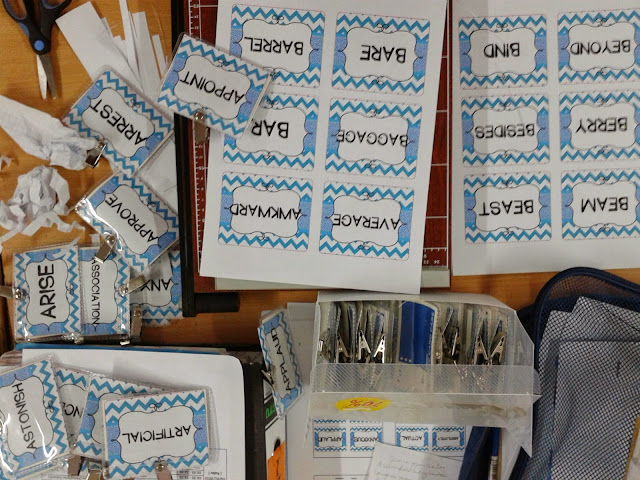Word Card Tag
Exposing vocabulary list to students of beginner level of English proficiency is always challenging especially when the students are at the age of 14 to 17 years old which had had an approximate 6 to 7 years experience of English language learning.
Talking from experience, the group of students, despite the level of their proficiency, hate to be treated as kids as they perceive themselves as grown up and that they have been learning the same thing for years. Therefore, they expect learning to be more serious, learning aids to be more mature and learning content to be more challenging.
Well, how do you make lessons on basic colours be more serious, mature and challenging?
If one is able to come out with the lesson, another question then arises; when are we going to get done exposing students with all the basic vocabulary so that we can proceed with the vocabulary that students are expected to know by the MOE in order to answer PT3 or SPM? Let's flip through PT3 or SPM papers. Honestly, students need to be at the intermediate level just to get a pass for both papers. For the beginners with knowledge on colours, shapes, animals and plants, they might only get a pass by luck or by memorising essays and lines.
Having to juggle with basic and frequently used vocabulary teaching, simple grammar teaching, literature, and skills teaching all at the same time is sure hard, worse in limited time frame. Teachers, though are miracle workers, are human who can simply get exhausted by the piling up tasks.
I had had an experience dealing with poor performing students. Those that despite 6, 7 or more years of learning English in schools, are still at beginner level of English language proficiency.
To deal with this issue, various attempts were made to expand their vocabulary yet often teachers were disappointed by the outcomes.
Past experience teaching in various education institutions helps me to recognise the need of Word Card Tag for the context. The underlying principle is simple. It is to increase students' engagement and visual experience to the target words.
Instead of keep bludgeoning students into memorising the target words, the use of Word Card Tag provide more ease to both teacher and students.
Word Card Tag
is an alternative that aims at helping students to expose to the words listed in the Malaysian KBSM Curriculum Specification. Considering the lack of time and opportunity for teachers to either expose or explain the meaning of each words to secondary school students (who mostly are at the pre-intermediate level), an effort is taken to make let students learn the words from their peers, of course, with teacher's guidance.
 |
| Preparing Word Card Tags |
Materials:
- List of targetted words;
- Computer, Printer
- Papers
- Card Tags
- Basket
Step 1: Preparing cards
Teachers select a list of targetted words. If students are really weak, teachers can opt to start with 100 frequently used words. If not, teachers can always refer to the list of word provided in Huraian Sukatan Pembelajaran (HSP). The words are typed nicely then printed out.
Step 2: Preparing Card Tags
This step is the easiest yet might take the longest time! It is to insert the cards into its card tags.
Step 3: Preparing Booklet
Each student will later be given a booklet. In the booklet, students are required to write their word and also some of their friends. The words should come with its meaning. Students are free to ask their friends the meaning of the word they are wearing or they could just refer to dictionary themselves.
Step 4: Making it work
Each student is given a card tag and a booklet. They have to wear their card tag throughout the week yet they could not take the tag home hence, a basket is needed to be placed in the classroom so that students could drop it before going back and put it on again when they are back at school. At the end of the week, teacher collect the tags and change the cards. The cycle goes on until teachers have run out of words.
 |
| A student putting on his word card tag |
How successful could this be?
A number of 50 beginner students tried using this learning method and it was a success. Students got to learn new words effortlessly and they had the chance to experience authentic English language interaction with friends when asking for the meaning of the words. However, this method only enables students to know the meaning of the word. This results students to have problems to correctly pronounce the word they had on them. Thus, to have better results, teachers could first brief students on the pronunciation of the weekly targetted words. Another downfall of this method is students found it hard to use the targetted words in their essays though they know the meaning of the words. In the context the study was conducted, it was okay for the students to only master the meaning of the targetted words first. Students used to have zero knowledge on targetted words making it hard for students to understand rubrics and passages. Mastering words only by sight helps them to better perform in their tests and examinations.
Nevertheless, I believe it is worth mentioning here that
the success of this method, or any methods, depends on the teachers who are applying or using it.
This method takes time and most importantly efforts - to print out, to keep on changing words and to make sure students are wearing the tags, but at the end, it will increase students' engagement and visual experience to the target words. Well after all, you'll reap what you've sown.
Comments
Post a Comment
You say: